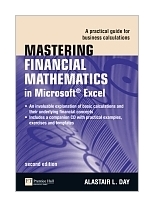|
||
• wydawnictwa polskie
• Zamów informacje o nowościach z wybranego tematu • kontakt
• Cookies na stronie |
MASTERING FINANCIAL MATHEMATICS IN MICROSOFT EXCEL: A PRACTICAL GUIDEDAY A. / FOR BUSINESS CALCULATIONSwydawnictwo: PEARSON ED FT/PH , rok wydania 2010, wydanie IIcena netto: Mastering Financial Mathematics in Microsoft © Excel provides a comprehensive set of tools, methods and formulas which apply Excel to solving mathematical problems. The book:
This fully revised and updated guide is an essential companion for anyone involved in finance, from company accountants, through to analysts, treasury managers and business students. Explaining basic calculations and using examples and exercises, the book covers:
Mastering Financial Mathematics in Microsoft Excel is a practical guide to using Excel for financial mathematics. This new edition includes:
Alastair Day has worked in the finance industry for more than 25 years in treasury and marketing functions and was formerly a director of a vendor leasing company specializing in the IT and technology industries. After sale to a public company he established Systematic Finance as a consultancy specializing in: ¦ Financial modelling – review, design, build and audit ¦ Training in financial modelling, corporate finance, leasing and credit analysis on an in-house and public basis throughout Europe, Middle East, Africa, Asia and America ¦ Finance and operating lease structuring as a consultant and lessor Alastair is author of three modelling books published by FT Prentice Hall: Mastering Financial Modelling, Mastering Risk Modelling and Mastering Financial Mathematics in Excel, all of which are in their second editions, as well as other books and publications on financial analysis and leasing. Alastair has a degree in Economics and German from London University and an MBA from the Open University Business School. Table of Contents Acknowledgements About the Author Conventions Overview Warranty and disclaimer 1 Introduction Overview Common Excel errors Systematic design method Auditing Summary Exercises 2 Basic financial arithmetic Simple interest Compound interest Nominal and effective rates Continuous discounting Conversions and comparisons Exercise Summary 3 Cash flows Net present value Internal rate of return XNPV and XIRR XNPV periodic example Modified internal rate of return Exercise Summary 4 Bonds calculations Description Cash flows Zero coupons Yield Yield to call Price and yield relationship Yield curve pricing Other yield measures Yield measures Exercise Summary 5 Bonds risks Risks Duration Convexity Comparison Exercise Summary 6 Floating rate securities Floating rates Characteristics of interest rate securities Yield evaluation Coupon stripping Exercise Summary 7 Amortization and depreciation Amortization Full amortization Delayed payments Sum of digits Straight line and declining balance depreciation UK declining balance method Double declining balance depreciation French depreciation Exercise Summary 8 Swaps Definitions How swaps save money Advantages of swaps Terminating interest rate swaps Implicit credit risk Worked single currency swap Valuation Cross currency swap Worked example Swaptions Exercise Summary 9 Forward interest rates Definitions Example forward rates Hedging principles Forward rate agreement Yield curves Exercise Summary 10 Futures Futures market Terminology Benefits Clearinghouse operation Bond futures Hedging mechanisms Hedging example one Hedging example two Exercise Summary 11 Foreign exchange Risk Spot rates Longer dates Equivalence Comparisons and arbitrage Exercise Summary 12 Options Description Terminology Underlying asset Call options Put options Example Covered call Insurance using a stock and a long put Pricing models Black Scholes model Call put parity Greeks Binomial models Comparison to Black Scholes Exercise Summary 13 Real options Real options Black Scholes model Binomial model Exercise Summary 14 Valuation Valuation methods Assets Market methods Multi-period dividend discount models Free cash flow valuation Adjusted present value Economic profit Exercise Summary 15 Leasing Economics of leasing Interest rates Classification Amortization Accounting Settlements Lessor evaluation Lessee evaluation Exercise Summary 16 Basic statistics Methods Descriptive statistics Probability distributions Sampling/Central Limit Theorem Hypothesis testing Correlation and regression LINEST function Exercise Summary Appendix Glossary Index 384 pages, Paperback Księgarnia nie działa. Nie odpowiadamy na pytania i nie realizujemy zamówien. Do odwolania !. |


